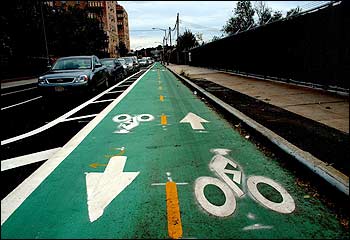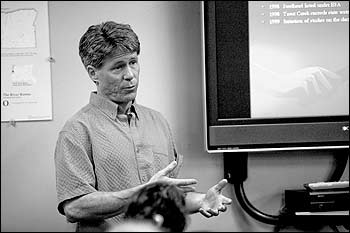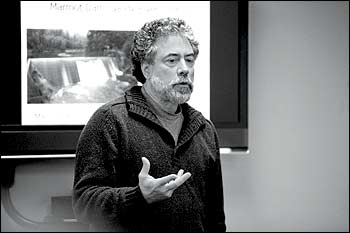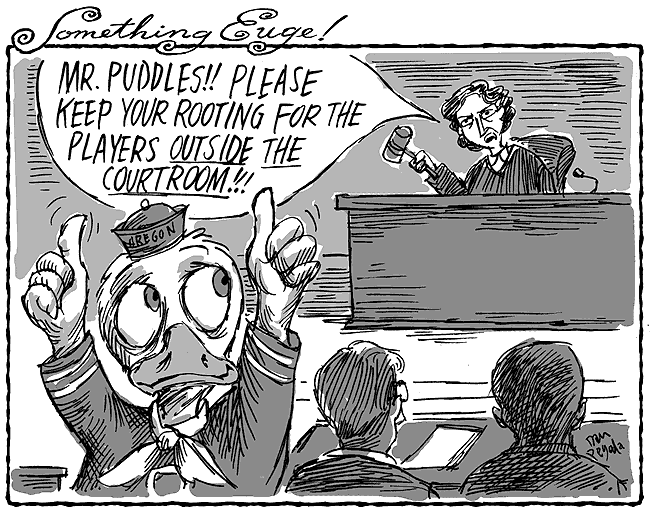
News Briefs: City May Convert Alder to Cycletrack | The Breaching of Little Dinky Dams | Follow the Money to Papé Beltway | No False Solutions | Storefront Art Project: Submit! | Meat is Mobile | UO Senate Denounces Pacifica Forum | Activist Alert | War Dead | Lane Area Herbicide Spray Schedule
Slant: Short opinion pieces and rumor-chasing notes
Happening People: Trevor Thibert
News:
Courthouse Garden
Collaboration paying off for Eugene
News:
Urban Mobility
Getting around without owning a car
City May Convert Alder to Cycletrack
The city may build the first European-style, separated two-way bike way in Eugene on Alder Street near the UO.
 |
The proposed Alder cycletrack could stretch from 18th Avenue to Franklin Boulevard. The city might also build an improved crossing of the busy street to access the riverfront trail system, and four on-street corrals for bike parking near 13th Ave. are also possible, according to associate city transportation planner David Roth.
But Roth said another option the city is considering is removing the existing bike lanes on Alder that have served heavy bike traffic for three decades and instead forcing bikes into car traffic. That alternative to remove the bike lanes to make room for two-way car traffic drew hisses and boos from the Eugene Bicycle and Pedestrian Advisory Committee meeting last week.
“I think it’s ridiculous that there’s even the two-way option up there,” said Shane Rhodes, a BPAC member and director of the local Safe Routes to School Program. Many people, especially families with kids, won’t feel safe sharing the busy road with cars, he said. “You’re not going to get more people biking.”
Roth said the city may install painted “sharrow” symbols on the street to encourage cars to “share” the space with cyclists.
“Since when do they share? That doesn’t work,” said BPAC member Harriet Behm.
BPAC member Jennifer Smith questioned whether the shared space would be safe for cyclists with so many college-aged drivers in the area. “With those 19-year-old idiot drivers, it’s not going to happen,” she said.
“Cars have every other street in this town,” Behm said. “Why do they have to have this?”
Asked by BPAC members which option he favored, Roth said, “I think the cycletrack is the way to go.” He said the cycletrack would include improved buffers between cars and cyclists. “Alder Street is one of the most important bicycle facilities we have in the city.” —Alan Pittman
(A version of this story first appeared at Eugenecycles.com)
THE BREACHING OF LITTLE DINKY DAMS
Hydropower is still a big player in the debate over clean energy, but in the Northwest some rivers have seen dams coming down instead of going up.
 |
| Hydrologist Bengt Coffin |
 |
| Hydrologist Gordon Grant |
However, as hydrologist Gordon Grant put it at a talk at the Public Interest Environmental Law Conference (PIELC) in February, “big dams and little dams are fundamentally different.” And it isn’t the big ones like Bonneville Dam that are up for removal. Or as Grant says, “most of them that have been taken out are LDDs, Little Dinky Dams.” But even small dams can have a large affect on salmon and rivers.
The PIELC panel “Dam Removal is Restoring Northwest Watersheds” dealt with the removal of three dams across the Northwest: the Marmot Dam on the Sandy River in Oregon in 2007; the Hemlock Dam removal in 2009 on Trout Creek in Washington and the upcoming Condit Dam removal on the White Salmon River in Washington.
Bengt Coffin, a hydrologist working in the Gifford Pinchot National Forest, discussed the Hemlock Dam removal in all its aspects from restoring a steelhead run to the fact that the removal was “not real popular with the local community,” which stood to lose the lake they had used for recreation. After the dam was removed, a recreation site was created on the restored river, Coffin said.
Coffin walked through the process of removing the dam from permitting to the actual removal, “Removing the dam was only a small part of it,” he said.
The process involved diverting the river, capturing all the fish in the reservoir (3,000 juvenile steelhead and a few adults) and then draining it, moving sediment, revegetating, digging a new channel and creating a new floodplain for the river.
Grant said among the reasons that dams have been coming down are relicensing and the need to repair aging dams. “We’re going to take them out or maintain them, or they’ll take themselves out.”
Much of what it takes to get a dam removed, he said, lies in being strategic and crafting partnerships. Grant, as a hydrologist, was speaking not only of the politics and paperwork behind dam removal but of involving scientists and others to study the removal and its results.
Compared to the overall number of dams across the country, the number of dams being taken out is quite small, but Grant said it’s a “strong symbolic” action.
“There are some dam-rich and some dam-poor countries, and we happen to be dam rich,” he said.
“Dam removal has become a legitimate option,” said Thomas O’Keefe of American Whitewater, a group that originally formed in the 1950s response to America’s upsurge in dam building. The question, he said, is, “What are the hydropower benefits relative to the environmental impact?”
To see time-lapse video of the breaching of the Marmot Dam, go to http://wkly.ws/fe or blogs.eugeneweekly.com — Camilla Mortensen
FOLLOW THE MONEY TO PAPÉ BELTWAY
The $250,000 renaming of Beltline Highway after millionaire Randy Papé has generated a grassroots outpouring of opposition in thousands of letters to the editor, web postings, online polls and Facebook fans.
So just why did Gov. Ted Kulongoski push ODOT to quickly rename the freeway after the deceased highway construction equipment mogul? Well, it just might have something to do with all the big checks Papé wrote Kulongoski over the years as one of the governor’s biggest campaign contributors.
Papé and his company and family members gave Kulongoski at least $60,000 in campaign contributions from 2002 to 2005, according to campaign finance reports. More recently, Papé gave an “Opportunity PAC” set up by Kulongoski $5,000 in cash plus $1,920 worth of in-kind contributions in 2007, according to state online data.
Papé and his company/family also contributed $21,125 to Associated Oregon Industries last year while the big business lobbying group was campaigning against tax increases on the wealthy and corporations designed to keep schools open. In 2008 Papé and company also gave $10,600 to the failed campaigns of Republican Rick Dancer for secretary of state and conservative Jim Torrey for Eugene mayor.
Last week the Eugene City Council quickly voted to unanimously endorse renaming Beltline for Papé with no debate. In contrast, renaming the much smaller Centennial Boulevard for Martin Luther King Jr. a few years ago took the council weeks of discussion and a split vote.
ODOT officials have publicly claimed locals should thank Papé for local road projects he supported after Kulongoski named him to the state Transportation Commission. But the road projects were funded mostly by federal money, which is supposedly allocated based on need and safety.
Papé’s time on the Transportation Commission was best known for his being a powerful last holdout in support of destroying a large swath of West Eugene Wetlands to build a new $200 million freeway. Critics questioned whether Papé, a dealer in highway construction equipment, had a conflict of interest. Critics also argued that the millions of dollars and decades of staff time spent on pushing the now defunct West Eugene Parkway diverted resources from more pressing transportation needs.— Alan Pittman
NO FALSE SOLUTIONS ALLOWED
The activist organization known as Rising Tide presented a panel at the PIELC Feb. 28 called “Reclaiming the Climate Movement.” In their presentation, Rising Tide members walked their audience through the ways big business energy companies write the environmental standards in America by misrepresenting themselves as environmentalists and doing so for their financial benefit.
Four presenters gave information about what they called “false solutions” for climate change. Specifically, they pointed to clean coal, nuclear energy, cap and trade, carbon offsets, agrofuels, biomass and waste incinerators, natural gas, large-scale hydroelectric dams, tree plantations and geo-engineering as perpetrators of pollution. All of these “solutions” for a cleaner environment, Rising Tide representatives repeatedly pointed out, are a distraction and are no replacement for stopping over-consumption of resources like electricity.
During the panel, Rising Tide presented a film by Annie Leonard (known for her previous short film The Story of Stuff) called The Story of Cap & Trade: Why You Can’t Solve A Problem With The Thinking That Created It (http://www.storyofstuff.com). This short film delved into reasons why cap and trade is one of the worst false solutions because it is almost impossible to regulate changes in how much polluting carbon is being unloaded into the atmosphere.
Cap and trade is the buying and selling of carbon credits between companies. Companies are only allowed to pollute so much, and when they exceed those amounts they can buy carbon credits from companies that pollute less. Companies who are supposed to pollute less sell their carbon credits to bigger polluters at a profit and continue to pollute at higher levels to meet rising demands for energy or goods. This is why Rising Tide promotes stopping cap and trade and penalizing polluters with fines instead of letting them pay to pollute.
“We’d like to see people spending more time directly on these false solutions,” said Brian Frank of Rising Tide North America, “and really looking at the corporations that are explicitly writing our climate policy.” — Shaun O’Dell
STOREFRONT ART PROJECT: SUBMIT!
Gentle threats to call in N.Y. artists contrasted with calls for collaboration during a Monday meeting of the Eugene Storefront Art Project.
The group, founded a few months ago, has placed sculpture by David P. Miller and photographs by Melissa Mankins in two empty downtown strorefronts but would like to have more proposals on file, said organizers Marc “Time” Gunther and Paula Goodbar.
“We would like to have rotating exhibits,” Time said, “and that’s why it’s important to have submissions from everybody.”
The third organizer, Peter Herley, added that it’s important to get local artists involved. “We have put out the call to artists in Portland, Seattle and some connections in New York, but we would first and foremost like to see Eugene and Lane County,” Herley said. Time called the submissions “sluggish” and urged artists who had said they would submit proposals to finish up the process.
Several artists attended the evening meeting at Fenario Gallery, which is about to close. Their concerns ranged from whether the Storefront Art Project had insurance to the difficulties of filling out the ESAP application. One artist suggested that the group hold a “beginners’ workshop” so that people who didn’t have artist résumés could understand the process, which she said was intimidating.
Goodbar, a local artist who deals with the proposals, encouraged all of the artists to talk with her about applications and to get in touch with her if they had questions or concerns. Time added, “As the artists, you have to make the first step,” but he said he would consider the idea of the workshop.
William Kasper, the president of the New Zone Art Collective, said “My experience has been, if artists know there are places to show, they’ll submit.” He invited group representatives to the May 2 “Zone4All” show reception and said, “If you have success stories, you need to publicize the hell out of them.”
Goodbar emphasized that the project welcomed group proposals and proposals for installations, including ideas from schools, and Herley reported that the group had a meeting planned with staff from the UO’s fine arts department.
For more information about the Eugene Storefront Arts Project, see http://esapblog.blogspot.com/ and for more info about the planned Eugene Arts Collective in the former Fenario space, see http://wkly.ws/ez — Suzi Steffen
MEAT IS MOBILE
In the fight to keep foods local and not eat factory-farmed foods that are trucked long distances, the issue of slaughter looms large. Some farmers can raise their cattle, pigs or chickens locally but then are faced with shipping them long, stressful distances before they are slaughtered.
Individuals who raise a cow or two a year or butcher only a couple of chickens can have their animals “custom” slaughtered, meaning a butcher can come to their place, slaughter and package the meat. But according to Denise Amann of the USDA, speaking at the Public Interest Environmental Law Conference (PIELC) panel on mobile meat processing, custom processing means that the meat isn’t inspected and goes back to the owner; it cannot be sold.
Mobile meat processing, however, involves creating a meat processing unit in the back of a semi-truck or trailer that can go from farm to farm and slaughter livestock according to USDA guidelines, from humane handling to cleanliness, and thus be sold to consumers.
In some parts of the country, CAFOs (Concentrated Animal Feeding Operations) have driven small farmers and smaller meatpackers out of business. “We’ve lost so many of our small butcher shops,” said Lori Fischer, co-director of the Nebraska Environmental Action Coalition. Mobile meat processing units give smaller farms the opportunity to have their animals butchered on site and then further cut and packaged elsewhere.
A red meat unit with two butchers can slaughter nine to 10 cows, 24 pigs or 40 lambs, said Amann.
The trucks meet federal or state guidelines for butchering the livestock and are fully contained, even down to the thousands of gallons of water needed for the process. Offal is collected and disposed of, though Amann said on some Native American reservations, the farmers prefer that the blood is returned to the soil to nourish it.
Oregon doesn’t have any mobile meat processing units, but Washington state has three and was the home of the first unit in 2002. According to Cheryl Ouellette of the Puget Sound Meat Producers Cooperative, her unit was the result of a collaborative effort among “farmers, butchers, chefs and eaters.” She spoke at the panel encouraging others to emulate this model and foster more opportunities for local, organic, grass fed beef and promote local farming.
For more information on mobile slaughter and niche meat processing, go to the OSU Extension Service’s web page at www.nichemeatprocessing.org — Camilla Mortensen
UO SENATE DENOUNCES PACIFICA FORUM
The UO University Senate unanimously approved a resolution March 10 denouncing “the hateful speech that has repeatedly emanated from the Pacifica Forum.” The Senate is the UO’s ranking legislative body and is composed of faculty, officers of administration, and other staff,
The resolution, sponsored by Margie Paris, dean of the UO School of Law and Bob Bussel, director of UO Labor Education and Research Center, asserts that “Pacifica Forum has become a vehicle for the expression of views that are wholly antithetical to the university’s commitments to critical inquiry, equal treatment, diversity, individual worth, and fostering a welcoming environment.”
Following months of protests, Pacifica Forum has been relocated off campus to the UO’s Baker Downtown Center, at 10th and Hilyard (see www.pacificaforum.org).
Bussel praised the Senate resolution and noted that other campus organizations have made similar statements, such as the Associated Students of the University of Oregon. He says the UO chapter of Service Employees International Union is considering taking a stand as well.
“We are on the verge of having all the major segments of the campus community on record condemning the Pacifica Forum’s condoning of hateful speech and its conduct of pseudo-debates that masquerade as serious intellectual inquiry,” Bussel says.
ACTIVIST ALERT
• Project Homeless Connect is from 9 am to 3 pm Thursday, March 18, at the Lane County Fairgrounds. See www.homelessconnect.org for information. The biggest needs this year are for volunteers, interpreters, attorneys and material goods such as sleeping bags, coats, hats and gloves. Checks can be made payable to United Way of Lane County — Project Homeless Connect, and sent to 3171 Gateway Loop, Springfield 97477.
• A benefit concert for Womenspace will feature Women on the Move, a trio of L.A. — area singer/songwriters, from 7 to 9:30 pm Thursday, March 18, at Eugene Faith Center, 1410 West 13th Ave. Tickets are $10 and seating is limited. Contact Womenspace at 485-8232.
• A training on “Building a Multi-racial Peace Movement” is planned for 5 to 9 pm Friday, March 19, at the old Whiteaker School, 21 N. Grand St. in Eugene. Sliding scale donation of $5-$30 is requested. RSVP to Michael Carrigan, calcpeace@efn.org or 485-1755. This training will help peace activists become better allies for communities of color and help the peace movement become more racially and ethnically diverse and inclusive of people of color, immigrants and refugees,” says Carrigan.
• The annual SOLV Beach Cleanup is Saturday, March 20, along the Oregon Coast. Volunteers can visit www.solv.org to pre-register or view a map of registration locations, or call SOLV at (503) 844 -9571 or (800) 333-SOLV (7658) for more information.
• Naturalist Dana Visalli, who recently returned from Afghanistan, will give a talk on “Women of Afghanistan: Impacts of War” at 7 pm Saturday, March 20, at the 1st United Methodist Church, 1376 Olive St. in Eugene. Free. Contact Mel Bankoff at melbankoff@comcast.net for more information.
• A benefit to help the survivors of the earthquake in Chile rebuild their homes and restore their livelihoods will be from 5 to 8 pm Sunday, March 21, at Cozmic Pizza, 199 W. 8th Ave. in Eugene. Latin American music, poetry and a silent art auction featuring local Eugene artists. Donation by sliding scale.
• Rebooting Democracy sponsored by the Oregon Bus Project is coming up March 26-28 in Bend. Registration and housing for the “Conference for People-Powered Politics” is at http://rebootingdemocracy.com
WAR DEAD
In Iraq
• 4,386 U.S. troops killed* (4,384)
• 31,716 U.S. troops injured** (31,706)
• 185 U.S. military suicides* (updates NA)
• 1,123 U.S. contractors killed (updates NA)
•104,313 to 1.2 million civilians killed*** (104,266)
• $712.1 billion cost of war ($710.3 billion)
• 202.5 million cost to Eugene taxpayers ($202.0 million)
In Afghanistan
• 1.011 U.S. troops killed* (1,004)
• 5,190 U.S. troops injured**(5,131)
• $259.5 billion cost of war ($257.5 billion)
• $73.8 million cost to Eugene taxpayers ($73.2 million)
* through March 15, 2010; source: icasualties.org; some figures only updated monthly
** sources: icasualties.org, defenselink.mil
*** highest estimate; source: iraqbodycount.org; based on confirmed media reports; other groups calculate civilian deaths as high as 655,000 (Lancet survey, 2006) to 1.2 million (Opinion Research Business survey, 2008)
LANE AREA HERBICIDE SPRAY SCHEDULE
• Near Lorane Elementary School and King Estates: Western Helicopter Services (503) 538-9469 will aerially spray for Sharon/Linde Kester (942-9264) on 510 acres with Garlon XRT (triclopyr ester), Velpar, Transline, Atrazine herbicides near the North Fork of Siuslaw River starting March 24 (Notice No. 781-00342).
• Near Marcola Elementary School: Oregon Forest Management (896-3757) will ground spray seven acres with imazapyr herbicide for Weyerhaeuser Company (988-7502) (No. 771-00108).
• Weyerhaeuser Research Spraying: Nathan Meehan (924-5270) for Weyerhaeuser in Albany will spray five acres near Parsons Creek with seven herbicides starting March 25 (No. 771-00384).
Compiled by Jan Wroncy, Forestland Dwellers: 342-8332, www.forestlanddwellers.org
|
SLANT • Getting a few thousand dollars out of ODOT for a crosswalk to save kids’ lives is like beating your head against asphalt. But if you want $250,000 to rename the Beltline after an anti-environmental highway construction equipment mogul who was a top political contributor to the governor, no problem, consider it done. Signs for the renamed “Randy Papé Beltway” will forever serve as a memorial, all right, to state corruption. We’ll keep calling it Beltline. With all the public outcry in print and online (even Facebook), ODOT would be wise to find some new chunk of concrete to name for Papé. • We suspect only part of the story was told about why Duck football star Jeremiah Masoli grabbed a couple of laptops from a frat house Jan. 24. We hear rumors that he was owed money by frat members, but for what? We will likely never know. His copping a plea avoids a trial and more potentially embarrassing headlines to haunt the UO. We hope Masoli considers this whole drama as an AFGO (Another Fucking Growth Opportunity), stays in school and comes back to play again. • What to do with Civic Stadium? The 4J School Board meets to talk about it this week, but a decision will not be made until after a public hearing June 2. An online survey garnered 776 responses, and the results can be found at http://wkly.ws/fn No big surprises. When given choices, responders favored 4J selling the property, but they also want the stadium and field preserved in public or nonprofit ownership. In the comments section, YMCA ownership and multiple sports were mentioned often. These preferred scenarios sound good to us, but the school district apparently cannot afford to give away the property, or even contribute to a re-use study, and the YMCA would have trouble raising enough money to both build a new facility and restore the stadium. The school board has a huge responsibility for determining what happens to this historic property — a responsibility that goes way beyond any short-term payment the district might receive. But one big question still remains: What creative combination of uses can be found for the stadium and property that will generate enough revenue to cover maintenance and pay off debts? Professional soccer? Another baseball franchise? • Health insurance reform is down to a vote this week, and it’s time for Congress to step up. Republicans cringe at the idea of the Democrats pushing though any legislation that’s substantive and positive for the American people. Passing reforms would make the D’s look effective and the R’s look irrelevant, and mid-term elections are coming. Conservative obstructionism is a calculated risk. But we don’t understand why some stubborn Democrats are holding the legislation hostage. Abortion funding? It’s a red herring fraught with subjective interpretation and speculation, but what is clear is that thousands of American children and adults are dying each year from lack of access to health care due to corrupt insurance industry practices. That’s the real pro-life issue. Let’s get it done and move on. Congress will have plenty of time to fix any problems that come up as elements of the legislation kick in. • This week we heard from retired Eugene lawyer Rafael Aldave who has traded being a stand-up attorney for being a stand-up comedian around town. He tells us, “Word on campus is that Phil Knight is making another donation for a building to help student athletes. This time it’s for an on-campus probation office.” • EW now has a lively presence on Facebook, and after just a couple of weeks we have 580 fans, and more every day. Some eyebrow-raising comments are popping up. You can also find links to the Next Big Thing and our new bike blog. Find us at http://wkly.ws/fp or check out our busy Twitter feed at twitter.com/eugeneweekly SLANT includes short opinion pieces, observations and rumor-chasing notes compiled by the EW staff. Heard any good rumors lately? Contact Ted Taylor at 484-0519, editor at eugeneweekly dot com |


TREVOR THIBERT
 |
When he was 3 1/2 years old, Trevor Thibert of Corvallis started taking fiddle lessons along with his grandma, Pem Winquist of Eugene. “He came down for nursery school on Monday and Tuesday,” says Winquist, who herself began fiddle lessons at LCC at age 50. “Monday after school we had a lesson with Jenny Humphrey, an amazing fiddle teacher.” Thibert made his public debut a year later, along with his grandma, at the Green Valley Nursing Home, and he has since played many nursing home gigs with her and with grandpa John Winquist, another musical late-bloomer, on guitar. “I’ve played at the Whiteaker Thanksgiving Dinner the last three years,” he adds. In the summer, he and his grandpa play old-time fiddle music at farmers’ markets in Corvallis, Springfield and Eugene. Contributions left in his fiddle case are matched by JW Fowler Construction, his dad’s employer, and donated to Linn-Benton Food Share and FOOD for Lane County. “We raised $350,” he says. In addition to his music, Thibert attends second grade at Mountain View Elementary and plays soccer, baseball, and chess. His chess team, the Mountain View Chess Eagles, almost went to state. “We needed one more win,” he says.